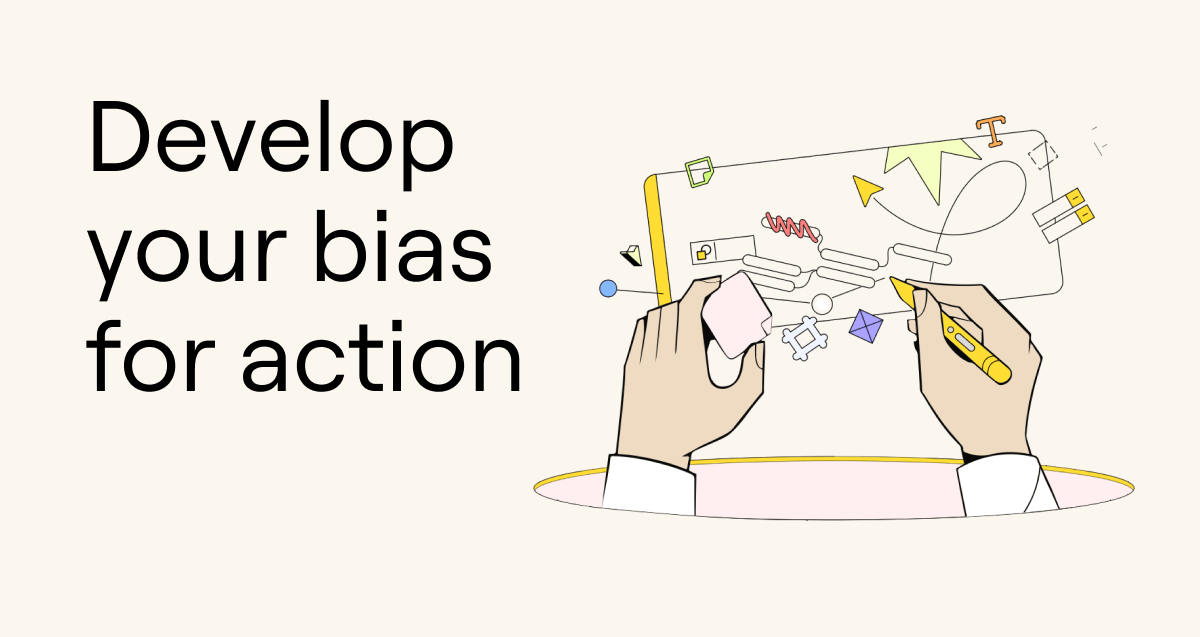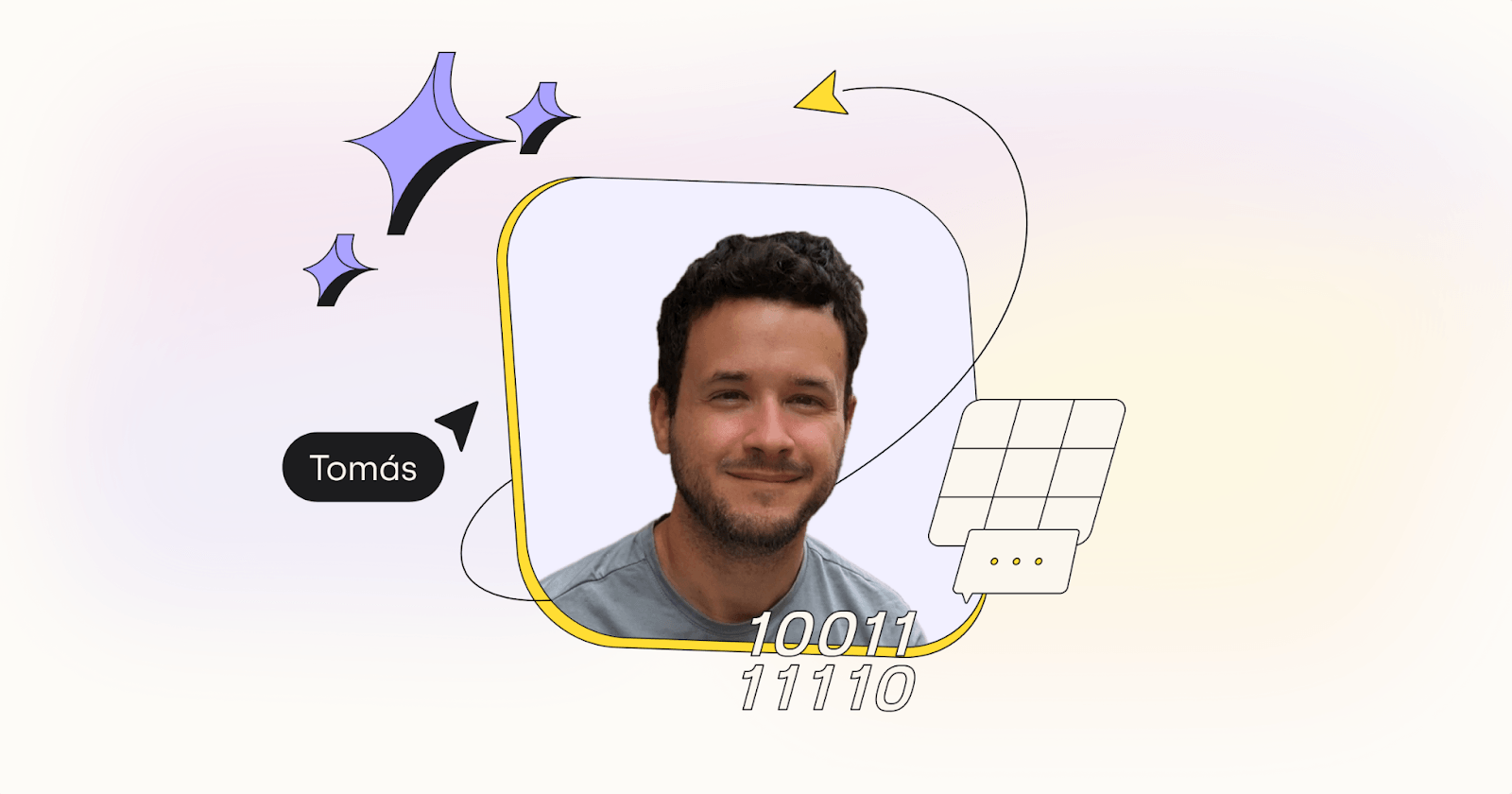We’ve all experienced the unpleasant feeling of being stuck at some point in our lives. The moments where you open your laptop and stare at your blank page for hours. The experience of sitting down to start a task but finding 15 other chores to prioritize instead. Or finally the feeling of being unable to move forward on a decision because of analysis paralysis. Feeling stuck in a cycle of distraction or procrastination can be a hard one to break.
So how do you move past procrastination and decision paralysis? We suggest building your bias for action. Bias for action is a concept and mindset that encourages us to make swift decisions and leap into action when we’re feeling uncertain.
In this article, we’ll explore:
- What bias for action is all about
- Why it’s important for your career
- Strategies to cultivate bias for action
- When it’s better not to act
Bias for action: What it is
Bias for action is the inclination to make decisions quickly and take tangible steps towards a goal even when faced with uncertainty. It’s a mindset that values progress over perfection, encouraging us to learn from experiences and move forward, rather than fearing failure.
Here at Miro, we encourage people to demonstrate their action for bias by:
- Accepting risk as part of the learning process
- Making calculated decisions that help remove roadblocks
- Stepping up and making the call when others stay on the sidelines
- Quickly seeking out answers they need to make a decision
Why bias for action matters for your career
Businesses today face fierce competition, and need to move with speed and agility in order to stay on top of client needs, manage technology changes, and lead through ambiguity. McKinsey explains that companies where employees are empowered to make quick and quality decisions outperform their competitors.
Fabian Struden, our Lead Product Manager says, “Something that’s so important for Product Managers is a bias towards action. Building products isn’t a science. So therefore you can never be 100 percent sure what the right next step is. Sometimes you have to take that leap of faith. Do as much as you can, and then you take that and learn from it. Through that process, the machine itself gets better.”
If you’re hoping to advance in your career within a business like Miro or elsewhere, you’ll make a good impression with decision makers and leaders by demonstrating your ability to push projects forward and make quick decisions.
On a personal level, if you’re waiting for the perfect time to make a meaningful change in your life, you may be missing out on all the good opportunities around you. Let’s take a career change, for example. You may have the instinct to make a change, but get tripped up on questions like, Will I be successful? Will I enjoy it? What if I waste my time? You can spend years spinning in circles. Alternatively, you can make the decision to make a change, course correct when required, and learn new useful skills along the way. If you wait until the perfect time, you may be waiting forever.
Strategies to develop your bias for action
Leadership, career development, and success requires decisive behavior. The more steps forward you take, the more new information you learn, and the easier making hard decisions becomes. Bias for action is a learned behavior which you can practice every day. Here’s how:
Set your criteria for decision making ahead of time
One thing that keeps us from making swift decisions is anxiety:
- Not feeling like we know enough
- Not feeling like we’ve evaluated enough of our options
- Not feeling like we’ve analyzed enough of the potential risks
But what exactly is enough, and how do you know when you’ve found it? Despite our desire to have 100% of the facts, we can make a sound decision without having all the information.
The 37% rule
The 37% explains that we only need to examine 37% of our options before moving forward with a decision. This rule states that if you had 100 options to choose from, you should analyze the first 37 options to help you calibrate and benchmark. After that, you have enough information to act on the next best option which comes up.
Simply put, 37% of your total decision making time should be spent gathering data. After that, you have enough information to confidently select the next option which meets your criteria.
Gather most of your critical information
Jeff Bezos believes that if you wait until you have 100% of the information you need, you’ve already waited too long to act. Instead, he recommends taking action once you’ve reached around 70% of the critical information.
Next time you’re evaluating job prospects, researching that new technology platform, or even deciding how many dates to go on, be sure to set yourself up with the necessary decision benchmarks ahead of time. This way, you won’t find yourself stuck in decision paralysis!
Prompt yourself to make a plan
Behavioral scientists from Harvard suggest that people are more likely to follow through with their intentions when they make a plan. Imagine you are applying for a job in tech. Simply trying to manifest it into will by saying “I’m going to land a job within a global tech startup” may not lead you to any meaningful action.
Rather, you’ll find more success by prompting yourself with a plan like, “I’m going to land a job in tech by applying to 10 jobs a day, polishing my resume, and networking with five people a week in the technology space.” Making a plan for yourself might mean taking a larger goal and breaking it down into smaller actionable steps which you can accomplish over time.
Take advantage of positive peer pressure
The same behavioral scientists also explain that positive peer pressure can influence how likely you are to turn intention into action. People are motivated to accomplish a task or follow through on a behavior when they feel others are doing the same.
If you want to influence yourself to take action, surround yourself with other people who do the same. Find a LinkedIn community, read our Life at Miro blog, find a mastermind group, or a friend or colleague who leans towards action. Share your progress regularly with them and use their success to fuel your own.
Practice to five second rule
Research suggests that there is a window between the moment you have an instinct to act, and the time in between where your thought patterns kill the instinct. Using this research, Mel Robbins created the 5 second rule, which recommends you count down from five, and at the end of the five seconds you launch yourself into action. She explains this works because we generally have a good idea of what we need to accomplish, but overthinking causes inaction.
By counting down from five, you mentally shift gears, you distract yourself from negative thoughts, and you kick yourself into gear. It’s a starting ritual that helps you create a positive pattern in your brain and moves you towards taking tangible actions.
Getting out of your own head
Getting lost in worry, self-doubt, and anxiety is an ingredient to procrastination. Getting out of your head and breaking negative thought patterns is a critical factor in building more decisive behaviors. Here’s a few strategies you can try:
Break your patterns
Do something to break your routine. Whether it’s taking a new class, meeting with a friend you’ve lost touch with, or taking a day trip somewhere, getting out of your comfort zone and into a new environment can help you break the negative loop you might be stuck in.
Ideally, I’ll do some sports like yoga, get some fresh air. Later I’ll get back to the task with a clear mind and full of new ideas.
Sometimes, getting out of your routine is all it takes for you to refresh your creativity and jump into action!
Challenge unhelpful thought patterns
Self reflect and challenge your negative thoughts and assumptions. A great place to start is actually writing out what you’re afraid of. Is it a failure? Looking stupid? Not being in control?
Once you can identify these unhelpful thoughts, you can challenge them and ask, is this fear real or imagined? Oftentimes, you’ll find that your fears are much greater in your head than they are in real life.
Another way to self reflect is to ask What is the cost of not taking action? Assess the likelihood of the worst case scenario happening. If the decision can be reversed without too much damage, you can always course correct and get yourself back on the right track.
Write out your mantras
Have a mantra in your head that you can echo whenever you need a boost of confidence or motivation. For example, you might keep the words “progress over perfection” on a sticky note next to your laptop.
I apply our values 'Play as a team to win the world' and 'Practice empathy to gain insight'. I ask my colleagues how they would approach the problem I am trying to solve to get a different perspective. It usually puts me on the right track to solve my issue, but also helps me get in someone else's shoes, learn from that, and apply this to my future work.
Whenever you’re feeling stuck, think about your mantra and repeat those words in the mirror until you feel motivated to jump into action. Encourage yourself like you would a friend.
Whenever you’re feeling stuck, think about your mantra and repeat those words in the mirror until you feel motivated to jump into action. Encourage yourself like you would a friend.
Sometimes, it’s better not to act
Equally important to taking action is giving yourself time to think, measure, and reflect.
Before beginning a project, leave yourself enough time to do your research, create your benchmarks, and set out objectives so that when you are ready to act, you can do so confidently. Remember, being biased towards action does not equate being impulsive.
After you’ve made a big change, you’ll need to practice patience as results can take time to show. In these moments, sometimes taking action is not the right decision. At Miro, we exercise patience, run retrospectives, and collect our lessons learned before moving on to the next big project.
Developing a bias for action, like any other skill, requires you to flex new muscles and create a new set of habits. When you push yourself towards action, the results breed clarity, learning, and growth. By striking the right balance between these approaches, you can navigate even the most complex set of choices with confidence, agility, and continuous improvement.








